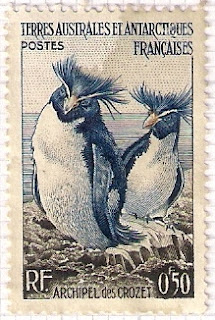Lots I would imagine. Australia has been an island for millions of years so its wildlife has evolved in a unique way and the country's post has always featured its fascinating flora and fauna on definitive stamps. The largest group of indigenous mammals are the marsupials which include the kangaroo
and the koala in its eucalyptus tree. Next the laughing kookaburra beloved of film makers to create atmosphere (the New South Wales site has a link to listen to their sound here,). The next group of unique creatures is the monotremes, the only egg-laying mammals in the world. So here comes the platypus
just about to go for a dive, they are expert swimmers. Now I will jump in time from these stamps of 1937 to 2009 and the the "Australian Bush Babies" series of which I only have two examples but they feature
yes the long time favourite and national animal of Australia and their cutest
the Koala which came on a card with one of those evocative Australian name cancels of Toowoomba. Now from the heat of Australia
wrap up warm its the Antarctic. The local inhabitants shown on this stamp have evolved to thrive in cold conditions but
humans have to wrap up warm. Here celebrating the first attainment of the Southern Magnetic Pole the trio under the union jack are Mackay, David and Mawson, the latter of who
would return to the Antarctic to explore the geology further . Of the expedition celebrated in this stamp Douglas Mawson wrote in the introduction to his book "The Home of the Blizzard" "One of the oft-repeated questions for which I usually had a ready answer, at the conclusion of Sir Ernest Shackleton's Expedition (1907-09) was, ``Would you like to go to the Antarctic again?'' In the first flush of the welcome home and for many months, during which the keen edge of pleasure under civilized conditions had not entirely worn away, I was inclined to reply with a somewhat emphatic negative. But, once more a man in the world of men, lulled in the easy repose of routine, and performing the ordinary duties of a workaday world, old emotions awakened. the grand sweet days returned in irresistible glamour, faraway ``voices'' called:......from the wilderness, the vast and Godlike spaces, The stark and sullen solitudes that sentinel the Pole.
Lastly I finish this journey with a visit to the Crozet Islands, a sub-antarctic archipelago of small islands in the Indian Ocean home to four species of penguin, the Macaroni (love that name), the King, Gentoo and
the one featured on this 1956 French Southern and Antarctic Territories stamp, the Rockhopper.
An entry to Viridian Postcard's Sunday Stamps

































